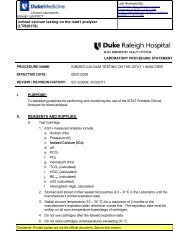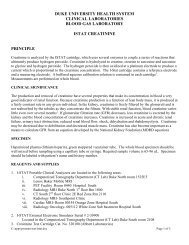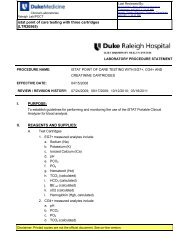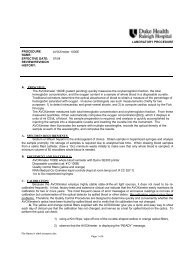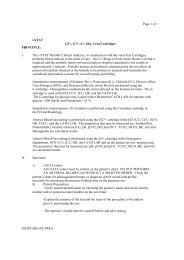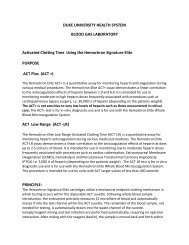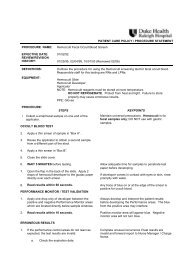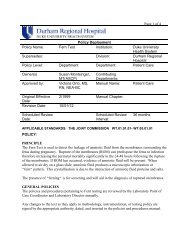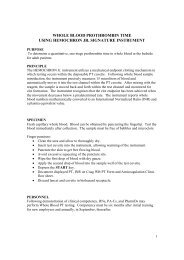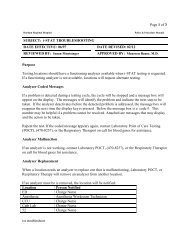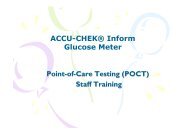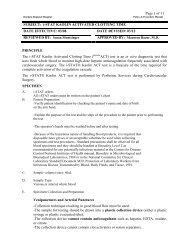POCT - Point of Care Testing
POCT - Point of Care Testing
POCT - Point of Care Testing
Create successful ePaper yourself
Turn your PDF publications into a flip-book with our unique Google optimized e-Paper software.
Introduction to <strong>Point</strong> <strong>of</strong> <strong>Care</strong>:•What is <strong>Point</strong> <strong>of</strong> <strong>Care</strong> (<strong>POCT</strong>)•What is the goal <strong>of</strong> <strong>POCT</strong>•What products fall under <strong>POCT</strong>•Some policy and procedures•Who is <strong>POCT</strong>
What is <strong>Point</strong> <strong>of</strong> <strong>Care</strong> <strong>Testing</strong>?<strong>Point</strong> <strong>of</strong> <strong>Care</strong> is any laboratory testperformed at the patient’s bedside.
What are the goals <strong>of</strong> <strong>POCT</strong>?•To assure the safety <strong>of</strong> the patients.•Maintain the regulatory compliance <strong>of</strong> all laboratorytests performed at the patient’s bedside to meetJCAHO and other regulatory agencies.•Monitor and maintain competency <strong>of</strong> all individualsperforming tests.•Monitor all aspects <strong>of</strong> testing to insure nursing staffperform testing accurately with products proven toperform correctly.•Assist nursing, with any issues, questions orconcerns with all aspects <strong>of</strong> <strong>POCT</strong>.
Where is <strong>POCT</strong> located?•Duke South, 4 th floor yellow zone, room 4706•681-6673•Pager 970-1333•Supervisor (Susan Utley) can be reached at:681-6706 or 970-3074
What areas perform <strong>POCT</strong> testing?•Patient care areas located in Duke North•Duke South Clinics•Hospital and PDC Clinics, and Life Flightsites across North Carolina (Greensboroto Lumberton)
Competency Training•Training occurs on your unit not during thisorientation.•Competency is revalidated within six monthsafter initial training.•Annual competency revalidation also occursduring the months <strong>of</strong> August and September(even if you were just trained).
Cannot perform glucose testing?•Meters have operator lock out.•Until you complete competency training onthe unit and the information is sent to the<strong>POCT</strong> by your trainer you are locked out.•Notify your trainer if you have completedtraining but cannot perform glucose testing.
Pr<strong>of</strong>iciency <strong>Testing</strong> for Tests• Several times a year the <strong>POCT</strong> staff will bring around Pr<strong>of</strong>iciencytests for each product used on your unit.• Samples are given to the Charge Nurse to assign randomly to the staffon the unit.• This process is checking, the procedure, training and how the productis working.• The test must be perform like a patient.• Results must not be compared.• These tests can not be scheduled, they have to be worked into thenormal work flow.
Policies and Procedures
<strong>Testing</strong> yourself or Co-Workers:•It is a work rule violation to test yourself orco-workers.•Exception to this is in an emergency, theperson will need to go to Employee Healthor the Emergency Room.•Use the emergency code <strong>of</strong> 000001 andcall the <strong>POCT</strong> <strong>of</strong>fice.
Always Identify the patient!Per Hospital policy all patients must beidentified with two identifiers:•“ All inpatients must be positively identified fromthe time the Hospital assumes responsibility fortheir care until discharge…..The identificationband must remain physically attached to thepatient at all times”•“All inpatients must be identified by an approvedarmband containing the patient’s name andmedical record number.”•“patients in outpatient settings will be identifiedwith two identifiers, the patient name and date <strong>of</strong>birth”
Attached Armbands should always be used!Per hospital policy: “No hospital employee is to perform any test orprocedure or transport any patient when an armband is missing ordefaced”NEVER USE ARMBANDS….• Found laying in the patient’s room• Taped to the bed• Found in the chart box• At the nursing stationWho does the armband belong to?
What is an Operator ID?Your Duke Unique ID is your Operator ID andis used to identify you as the personperforming a glucose test.Scan the barcode on the front <strong>of</strong> your badge.If your ID comes up “Invalid Operator” callthe <strong>POCT</strong> Office at 681-6673.
Badges should be worn between theshoulder and waist.
Would you let someone borrow yourcredit card or Social Security number?Why you must never allow anyone to use your badge or borrowsomeone else’s:•Remember you are legally responsible for all testsperformed using your ID,•Your name is tied to every glucose test performed usingyour ID,•It is a work rule violation (can be grounds for dismissal),•If a co-worker cannot use the glucose meter using theirbadge, there is a valid reason and they should addressthis with their trainer.
What products fall under<strong>POCT</strong>?
•Gastroccult•Hemoccult•HemoCue•H. pylori•Nitrazine paper•pH paper•Urine dipsticks•Urine hCG•Urine Specific Gravity•Whole blood glucose<strong>POCT</strong> Tests include:
Whole Blood Glucose
•At this time Abbott PCx glucose meter isbeing used.•The hospital system will be changing tothe Roche Inform in the near future.
Always scan the armbandattached to the patient.
Scanning is everything•Scanning prevents manual entry errorsand results going to the wrong patientchart.•If you must manually enter a number,double check it before you press the enterbutton. This should be a rare issue unlessyou work in the outpatient areas.
000001•Five zeros and a one (000001) is the onlynumber that will not attempt to go to apatient’s chart in the Browser.•You must call the <strong>POCT</strong> <strong>of</strong>fice with thefollowing information: your name, location,date and time <strong>of</strong> test, result and thepatient’s name and history or accountnumber.
Whole Blood GlucosePCx Controls (QC)•QC should be performed every 24 hours•Meters do have QC lockout and will notifyyou when QC needs to be performed•Expiration is 90 days from the date openedor the manufactures outdate. Which evercomes first.
Always keep the glucose meter flatwhile running a test.
Holding a meter straight upand down cancause liquid to run into the port.Damaging the meter.
If you have problems with your meter callthe <strong>POCT</strong> <strong>of</strong>fice at681-6673
Useful information can be found in the lid<strong>of</strong> the carry case.
Check products for Validation Stickers.
Check products for expiration dates.
Hemoccult
Hemoccult - Major points:•Add sample from 2 different areas.•Wait 3-5 minutes after you apply thesample to prevent false negative readings.•If the card is removed from the patient’sroom, it must be labeled.•Performance monitors (QC) must reactcorrectly, otherwise your test is invalid
Hemoccult Performance Monitors
Gastroccult
Gastroccult - Major points:•Always check the pH first and note (wealready know the pH <strong>of</strong> the developer is 7)•Hold the card toward light to see a lightpositive.•Check the performance monitors, if theydo not work, the test is invalid.
Gastroccult Performance Monitors:
Urine Dipsticks
Urine Dipsticks - Major points:•Be sure urine is mixed•Blot the dipstick•Timing is everything•Be careful not to misalign strip whenreading
Who are the <strong>POCT</strong>Staff?
Staff Members
Here is the real <strong>POCT</strong> team:Chris, Susan, Mary and Donna



